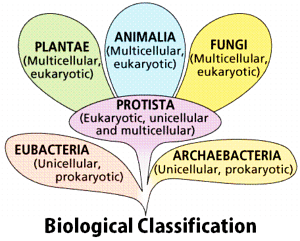Question:
Taxonomic hierarchy refers to
Taxonomic hierarchy refers to
Updated On: Jun 5, 2023
- step-wise arrangement of all categories for classification of plants and animals
- a group of senior taxonomists, who decide the nomenclature of plants and animals
- a list of botanists or zoologists, who have worked on taxonomy of a species or group
- classification of a species based on fossil record
Hide Solution
Verified By Collegedunia
The Correct Option is A
Approach Solution - 1
Taxonomic hierarchy refers to the step-wise arrangement of all categories for classification of plants and animals.
Was this answer helpful?
0
0
Hide Solution
Verified By Collegedunia
Approach Solution -2
The Linnaean order is made up of a gradual system of reviewed ordered positions known as taxa. Every taxon may have a few lesser taxa that may be distinguished by certain common characteristics. The realm, phylum or division, class, order, family, variation, and species are the seven primary ordered positions in slipping requests.
"Taxonomic progression is the process of organizing various life forms into progressive levels of natural classification, either in a decreasing or expanding request from realm to species and vice versa."The realm is the most important level of arrangement, which is divided into subgroups at several levels. Animalia, Plantae, Fungi, Protista, and Monera are the five domains in which living life forms are classified. The class was the broadest position in the ordered chain of importance until phyla were not presented. Realm Animalia consists of 108 classes including class Mammalia, reptilia, aves, and so forth Nonetheless, the classes utilized today are not quite the same as those proposed by Linnaeus and are not utilized much of the time.
"Taxonomic progression is the process of organizing various life forms into progressive levels of natural classification, either in a decreasing or expanding request from realm to species and vice versa."The realm is the most important level of arrangement, which is divided into subgroups at several levels. Animalia, Plantae, Fungi, Protista, and Monera are the five domains in which living life forms are classified. The class was the broadest position in the ordered chain of importance until phyla were not presented. Realm Animalia consists of 108 classes including class Mammalia, reptilia, aves, and so forth Nonetheless, the classes utilized today are not quite the same as those proposed by Linnaeus and are not utilized much of the time.
Was this answer helpful?
0
0
Top Questions on biological classification
- Red Data Book describes
- WBJEE JENPAS UG - 2022
- Biology
- biological classification
- Which of the following statements is correct?
- NEET (UG) - 2021
- Biology
- biological classification
- Match the compounds of Column I with their functions in Column II.
Column I Column II 1. Trypsin p. Fights infectious agents 2. GLUT - 4 q. Is an intercellular ground substance 3. Collagen r. Works as an enzyme 4. Antibody s. Enables glucose transport into cells - KCET - 2021
- Biology
- biological classification
- Match the organisms in column-I with habitats in column-II Select the correct answer from the options given below :-
- NEET (UG) - 2019
- Biology
- biological classification
- Match Column - I with Column - II.
Column - I Column - II Saprophyte - Symbiotic association of fungi with plant roots Parasite - Decomposition of dead organic materials Lichens - Living on living plants or animals Mycorrhiza - Symbiotic association of algae and fungi Choose the correct answer from the options given below :- NEET (UG) - 2019
- Biology
- biological classification
View More Questions
Questions Asked in NEET exam
- A chemical reaction proceeds into the following steps Step I,$\hspace15mm 2A \rightleftharpoons X$ fast Step II,$\hspace10mm X + B \rightleftharpoons Y$ slow Step III,$\hspace10mm Y + B \rightleftharpoons $ Product fast The law for the overall reaction is
- Delhi UMET/DPMT - 2011
- Chemical Kinetics
- A solution is $0.1 M$ with respect to $Ag ^{+}, Ca ^{2+}, Mg ^{2+}$ and $Al ^{3+}$, which will precipitate at lowest concentration of $\left[ PO _{4}^{3-}\right]$ when solution of $Na _{3} PO _{4}$ is added?
- Delhi UMET/DPMT - 2011
- Equilibrium
- How many $ 1\,\mu F $ capacitors must be connected in parallel to store a charge of $1\, C$ with a potential of $110\, V$ across the capacitors?
- Delhi UMET/DPMT - 2011
- electrostatic potential and capacitance
- Most stable carbocation is
- Delhi UMET/DPMT - 2011
- Organic Chemistry- Some Basic Principles and Techniques
- Given a gas phase reaction, $\hspace10mm 2A(g)+B(g) \rightleftharpoons C(g)+D(g)$ Which one of the following changes will affect the value of $K_c$?
- Delhi UMET/DPMT - 2011
- Equilibrium
View More Questions
Concepts Used:
Biological Classification
The process of grouping living organisms into categories is called biological classification. The most modern 5-kingdom classification was put ahead by an eminent scientist R.H.Whittaker. The five-kingdom classification is based on the criteria like cell structure, mode of nutrition, body form, and reproduction. One of the most important characteristics of this system is that it follows the evolutionary sequence of living organisms. The organisms are classified into distinct taxa or levels like Kingdom, Phylum, Division, Class, Order, Family, Genus, and Species. The 5 kingdoms are as follows:




